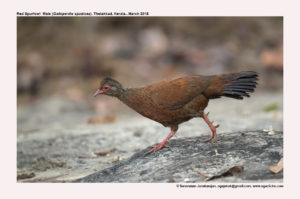
Red-Spurfowl Galloperdix spadicea
Etymology:
- Galloperdix : Latin word gallus- farmyard cock; perdix- partridge
- Spadicea : Latin word for Chestnut coloured
Vernacular Names: Hindi, M.P.: Chhotijunglimurghi, Guj: Chokhara, Mar: LalChakotri, Kokatri, Kastoor, Ta: Sarawa/Saravookozhi, Chakuttikozhi, Te: Yerrakodi, Jitakodi, Mal: Mullankozhi, Thavittu-thalayankattukozhi, Kan: Chaachukoli
Distribution in India: Resident of Peninsular India.
Description: Size of male is 44–48 cm,tail size is 16·5–18 cm; female size is 39·5–42 cm, tailsize is 14–15·5 cm; Wt. of 410–655 g. Overall reddish-brown, it is a large partridge-like bird has a somewhat long tail. The upper parts are brown with dark barring while the face and neck are greyer in the male. The underside is rufous with dark markings and both sexes have a red facial skin patch and red legs with one or two spurs,while females may have none. Downy chicks have an unmarked cinnamon brown head, a dark brown band along the back bordered by creamy stripes edged with thin lines of dark brown. The male of the distinctive Kerala race, G. s. stewarti has all-chestnut plumage, including the head feathers. Both sexes have long feathers on the crown that can be erected into a crest.
Habitat: It is found in a variety of habitat types, both dry and moist, especially those in hilly ground that afford cover, Lantana thickets or scrubby bamboo; often close to cultivation. It is found from 300–1250 m.
Food habits : It eats seeds, berries, fruits like figs, and various invertebrates. Mainly forages within vegetation, though will feed on paths and at field edges in early morning and evening.
Breeding : They breed in spadicea in peninsular India Jan–Jun; caurina May–Jun in North West India; and stewarti in South West India in most months except the wettest (Jun–Aug). They are Monogamous. The nest is a shallow scrape, sometimes lined with a few pieces of grass and some leaves, amid dense vegetation. They lay a clutch of 2–5 eggs. The incubation is done by female but both parents tend chicks.
Red-SpurfowlGalloperdix spadicea
Etymology:
- Galloperdix : Latin word gallus- farmyard cock; perdix-
- Spadicea : Latin word for Chestnut coloured
Vernacular Names: Hindi, M.P.: Chhotijunglimurghi, Guj: Chokhara, Mar: LalChakotri, Kokatri, Kastoor, Ta: Sarawa/Saravookozhi, Chakuttikozhi, Te: Yerrakodi, Jitakodi, Mal: Mullankozhi, Thavittu-thalayankattukozhi, Kan: Chaachukoli
Distribution in India: Resident of Peninsular India.
Description:
Size of male is 44–48 cm,tail size is 16·5–18 cm; female size is 39·5–42 cm, tailsize is 14–15·5 cm; Wt. of 410–655 g. Overall reddish-brown, it is a large partridge-like bird has a somewhat long tail. The upper parts are brown with dark barring while the face and neck are greyer in the male. The underside is rufous with dark markings and both sexes have a red facial skin patch and red legs with one or two spurs,while females may have none. Downy chicks have an unmarked cinnamon brown head, a dark brown band along the back bordered by creamy stripes edged with thin lines of dark brown. The male of the distinctive Kerala race, G. s. stewarti has all-chestnut plumage, including the head feathers. Both sexes have long feathers on the crown that can be erected into a crest.
Habitat:
It is found in a variety of habitat types, both dry and moist, especially those in hilly ground that afford cover, Lantana thickets or scrubby bamboo; often close to cultivation. It is found from 300–1250 m.
It eats seeds, berries, fruits like figs, and various invertebrates. Mainly forages within vegetation, though will feed on paths and at field edges in early morning and evening.
Breeding :
They breed inspadicea in peninsular IndiaJan–Jun; caurina May–Jun in North West India; and stewarti in South West India in most months except the wettest (Jun–Aug). They are Monogamous. The nest is a shallow scrape, sometimes lined with a few pieces of grass and some leaves, amid dense vegetation. They lay a clutch of 2–5 eggs. The incubation is done by female but both parents tend chicks.